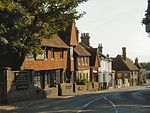RAF Wartling
History of East SussexRoyal Air Force stations in East SussexRoyal Air Force stations of World War II in the United KingdomUse British English from November 2017
RAF Wartling was a Royal Air Force station located near the village of Wartling in East Sussex. It was a Second World War and later Cold War Ground Controlled Interception (GCI) station built to complement the nearby Chain Home station at RAF Pevensey.
Excerpt from the Wikipedia article RAF Wartling (License: CC BY-SA 3.0, Authors).RAF Wartling
Wartling Road, Wealden Pevensey
Geographical coordinates (GPS) Address Nearby Places Show on map
Geographical coordinates (GPS)
| Latitude | Longitude |
|---|---|
| N 50.84 ° | E 0.34978 ° |
Address
Wartling Road
Wartling Road
BN27 1RY Wealden, Pevensey
England, United Kingdom
Open on Google Maps










